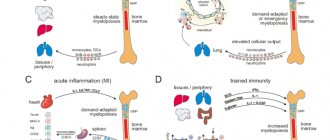Heavy periods (hypermenstrual syndrome or menorrhagia) is a condition in which the volume of menstrual blood is more than 100 ml per day. The permissible norm is 80 ml. The pathological process is accompanied by other unpleasant symptoms and indicates disturbances in the woman’s body.
More than 30% of the world’s female population suffers from heavy periods, but they don’t even know that the problem can be solved with the right approach. Just one consultation with a gynecologist and the right treatment program will help you avoid wasting money on intimate hygiene products, as well as serious complications.
Causes of heavy menstruation
Gynecologists diagnose natural heavy periods and deviations from the norm. Hypermenstrual syndrome during puberty or the premenopausal period is considered natural, that is, normal. In this case, the reason is hormonal imbalance, but it is a consequence of the restructuring of the body. After a few months, the function of the genitourinary system stabilizes: the cycle normalizes or the performance of the ovaries decreases.
Much more dangerous are hormonal disorders associated with uncontrolled use of drugs (oral contraceptives, anti-inflammatory drugs) or diseases of the endocrine glands: diabetes mellitus, hyperfunction of the thyroid gland.
Deviations from the norm occur more often due to diseases of the genitourinary system:
- Endometriosis;
- Polycystic ovary syndrome;
- Benign, malignant neoplasms;
- Anomalies of organ development;
- Inflammatory processes.
Miscarriages or ectopic pregnancies, as a result of bleeding, are a normal phenomenon, but they are not classified as heavy menstruation: they do not occur on time and do not depend on natural physiological processes.
Hypermenorrhagia develops in the presence of other diseases:
- Blood clotting disorder;
- Hypertension;
- Neuralgia;
- Psychical deviations;
- Cardiovascular pathologies;
- Diseases of the liver, kidneys.
We must not forget about trauma: for example, careless insertion of a tampon or cup can increase the total blood volume during menstruation. Physical activity and stress also often cause an increase in the volume of menstruation.
Possible complications
Heavy bleeding during menstruation can cause dangerous complications for a woman. Anemia begins to develop. Low iron levels negatively affect a woman’s well-being, causing drowsiness, dry skin, weakness, brittle nails and hair.
If the cause of intense bleeding is endometriosis, then in the absence of proper treatment the woman may remain infertile. Malignant neoplasms lead to death. Large blood loss can cause hemorrhagic shock, which leads to death.
Symptoms of hypermenorrhagia
Excessive blood loss is an independent symptom indicating the disease. If a woman changes tampons or pads every hour because they are full, she should consult a doctor.
Often the problem is accompanied by other symptoms:
- Blood clots on underwear, pads;
- Painful sensations in the lower abdomen, lower back;
- Severe fatigue;
- Weakness.
If hypermenorrhagia is not treated, other symptoms will be added to the existing ones. Against the background of heavy blood loss, despite the restoration of its volume, anemia occurs. You can suspect deviations from the norm based on the following signs:
- Excessive pallor, bluishness of the skin;
- Fragility, dullness of hair, nails;
- Dizziness, headaches;
- Problems with concentration, drowsiness;
- Irritability, insomnia.
Kinds
The main types of bleeding include:
- dysfunctional;
- juvenile;
- breakthrough;
- profuse.
The main signs of dysfunctional bleeding are considered to be large blood loss and/or too long periods. The risk group mainly includes adolescents and women during menopause. The provoking factor is considered to be an excessive amount of sex hormones. To eliminate this pathology, hormonal therapy is required.
This type of bleeding is divided into ovulatory and anovulatory. The first is characterized by the manifestation of an abnormal cycle. This means that there is a small discharge or short periods, more than one month apart. Anovulatory symptoms are characterized by cycle disruption, significant blood loss, loss of appetite, poor health and drowsiness.
Juvenile bleeding may occur seasonally. This can be explained by the fact that the corpus luteum is not formed due to hormonal imbalance. Breakthrough bleeding occurs as a result of problems with the uterus, which can be caused by an intrauterine device. In addition, they can be caused by taking hormonal contraceptives.
Profuse blood loss is quite difficult to distinguish from normal menstruation, since they are not characterized by the presence of pain. The only sign may be a severe loss of fluid mobile connective tissue with scarlet discharge.
Diagnostics - how to determine the causes?
It is usually not difficult to diagnose heavy periods. However, it is important for the gynecologist to find out the cause of this disorder. A chairside examination will help determine the condition of the genitourinary system. The doctor chooses a two-handed method using speculums, examining the vagina and other organs for integrity, the presence of inflammatory processes, and neoplasms. The specialist immediately takes smears for cytology and microflora to rule out precancerous or cancerous conditions.
For a more thorough examination, the gynecologist performs a colposcopy. The doctor performs a diagnostic curettage - it is necessary to submit particles of the upper layer of the vaginal mucosa and cervix for histology and microscopy.
After a general and gynecological examination and questioning of the patient, the doctor prescribes general and specific laboratory blood tests and urine tests. Laboratory assistants determine the level of hemoglobin, the degree of blood clotting, cancer cells, antibodies to bacteria and viruses. Blood agents are present in the urine of liver and kidney diseases.
Additionally, the gynecologist prescribes ultrasound, MRI, CT, and radiography of the pelvic organs. Studies will reveal structural changes in the genitourinary system.
Uterine bleeding
Uterine cancer
Cervical cancer
7183 January 27
IMPORTANT!
The information in this section cannot be used for self-diagnosis and self-treatment.
In case of pain or other exacerbation of the disease, diagnostic tests should be prescribed only by the attending physician. To make a diagnosis and properly prescribe treatment, you should contact your doctor. Uterine bleeding: causes of occurrence, what diseases it occurs with, diagnosis and treatment methods.
Definition
Every woman and girl can experience abnormal uterine bleeding. They are a signal of dysfunction of the reproductive, endocrine or nervous systems. This condition usually occurs suddenly, so it is necessary to clearly understand what to do if abnormal uterine bleeding develops.
The uterus is an organ of the female reproductive system, consisting of three layers: internal (endometrium), middle muscular (myometrium) and external (perimetry), which is adipose tissue surrounding the outside of the uterus.
The uterus, like other organs of the female reproductive system, undergoes significant changes during the menstrual cycle, which, in turn, is associated with the maturation of eggs in the ovaries.
The germ cells (cells that are the precursors of the egg) laid down during the intrauterine development of the female fetus are activated and enter into the process of further development every month, but not all at once, but in a strictly defined quantity (about 20–30 cells), while fully maturing only one cell. It leaves the ovary, enters the fallopian tube, through which it gradually moves towards the uterus. If the egg has been successfully fertilized by a sperm, then a zygote is formed - the first cell of the future embryo, which begins to divide and, reaching the uterine cavity, is fixed (implanted) on the surface of the endometrium. If fertilization does not occur, then the egg does not remain in the uterine cavity and is subsequently excreted along with normal menstrual flow. In the process of implantation, the most important role is played by the epithelium lining the uterine cavity from the inside - the endometrium. From the beginning of the menstrual cycle, it grows, thickens and reaches its maximum thickness at the time of ovulation. Next, the endometrium is loosened, which is necessary for successful implantation. If implantation does not occur, then before the start of a new menstruation, endometrial rejection begins, which is preceded by spasm of the uterine arteries. It is the spasm of the uterine arteries that causes the development of pain during the premenstrual period. Next, the arteries relax and become fragile, which leads to the development of bleeding under the endometrium with its further rejection.
Thus, it is the rejected endometrium that is the main component of the discharge from the uterine cavity during uterine bleeding.
Types of Uterine Bleeding
All uterine bleeding can be divided into normal menstrual bleeding and abnormal uterine bleeding. Normal menstrual bleeding is characterized by frequency of occurrence, a certain duration of the menstruation itself (on average from 3 to 7 days) and a small loss of blood (usually about 40-60 ml).
Bleeding that differs in its characteristics from those listed above is considered abnormal in women who have reached reproductive age.
These bleedings are excessive in duration (more than 7 days), volume of blood loss (more than 80 ml), and frequency (including intermenstrual bleeding).
Separately, abnormal bleeding of the pubertal, perimenopausal and postmenopausal periods is distinguished, which is associated with the peculiarities of the functioning of the reproductive and neuroendocrine systems during these age periods.
Possible causes of abnormal uterine bleeding
Identification of the causes of abnormal uterine bleeding formed the basis of the PALM-COEIN classification, widespread throughout the world (many domestic gynecologists also use this classification, indicating this abbreviation in the diagnosis). In accordance with it, the causes of uterine bleeding are divided into organic (structural, accessible to visualization and detection by ultrasound, MRI, etc.) diseases of the female reproductive system and functional, caused by impaired functioning of the reproductive system in the absence of visible changes, as well as those arising from -for disorders of the endocrine system, blood coagulation system, etc.
What diseases cause abnormal uterine bleeding
What diseases are hidden under the abbreviation PALM-COEIN?
- Polyp (polyp) – the presence of polyps, i.e. formations, often benign;
- Adenomyosis (adenomyosis) is a type of endometriosis in which the endometrium grows deep into the wall of the uterus;
- Leiomyoma (leiomyoma, or myoma) is a benign tumor that develops from myometrial tissue;
- Malignancy (malignancy) – malignant (oncological) processes developing from uterine tissue;
- Hyperplasia (hyperplasia) – excessive growth of the endometrium;
- Coagulopathy (coagulopathy) – disorders of the blood coagulation system (for example, hemophilia, von Willebrand disease, etc.), manifested by a tendency to bleeding of various locations (not only uterine bleeding, but also nasal, post-injection, etc.);
- Ovulatory dysfunction (ovulatory dysfunction) – disruption of the functioning of the ovaries, leading to certain changes in the process of egg maturation;
- Endometrial (endometrial dysfunction) – disruption of the functioning of the endometrium in the absence of its visible changes;
- Iatrogenic (iatrogenic cause) – uterine bleeding as a complication in the process of treating a particular disease;
- Not yet classified (not yet classified cause) - other rare or unknown causes of uterine bleeding.
Which doctors should I contact if abnormal uterine bleeding occurs?
Emergency treatment of abnormal uterine bleeding is carried out by an obstetrician-gynecologist. After the bleeding has stopped, the gynecologist continues to care for such a patient, often together with an endocrinologist and mammologist. If abnormalities in the blood coagulation system are detected, the patient is sent for a mandatory consultation with a hematologist (a doctor specializing in blood diseases).
Diagnosis and examination of abnormal uterine bleeding
Diagnosis of the cause of abnormal uterine bleeding begins with a detailed interview of the patient in order to identify risk factors for a particular disease and clarify the circumstances of the development of bleeding. The dates of the last normal menstruation must be specified, and pregnancy is excluded (in the laboratory) using a blood test for hCG (human chorionic gonadotropin).
Treatment of heavy periods
The gynecologist must not only reduce the symptoms, but also eliminate the cause of the problem. Otherwise, it is impossible to get rid of hypermenstrual syndrome.
Conservative treatment methods are limited to normalizing hormonal levels, the functioning of the endocrine glands, restoring blood circulation and hematopoiesis.
To reduce blood loss, doctors prescribe ascorbic acid, rutin, and anti-inflammatory drugs. For heavy discharge, specialists use calcium gluconate. To restore hemoglobin levels, doctors choose drugs rich in iron.
The patient may be undergoing inpatient or outpatient treatment, but in both cases she is shown complete rest and a balanced diet. Immediately after the end of menstruation, the woman is prescribed physical therapy: electrophoresis, phonophoresis, diathermy, ozokerite.
Surgery
If the doctor has diagnosed injuries or other violations of the integrity of the tissues of the vagina, uterus or cervical canal, surgical intervention cannot be avoided. Endometriosis, neoplasms, and inflammatory processes also do not always respond to conservative therapy.
Surgeons excise the affected tissue and connect it by suturing the edges of the wound. In situations where a woman is over 40 years old, gynecologists often choose to remove the uterus in order to completely eliminate complications. Sometimes specialists perform supravaginal amputation of the uterus - removal of the genital organ while preserving the vagina.
Also, sometimes operations are performed to excise or remove organs of other body systems: for example, to restore hormone levels, part of the overgrown thyroid gland is removed.











